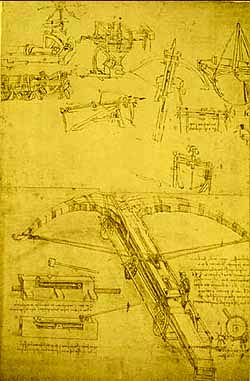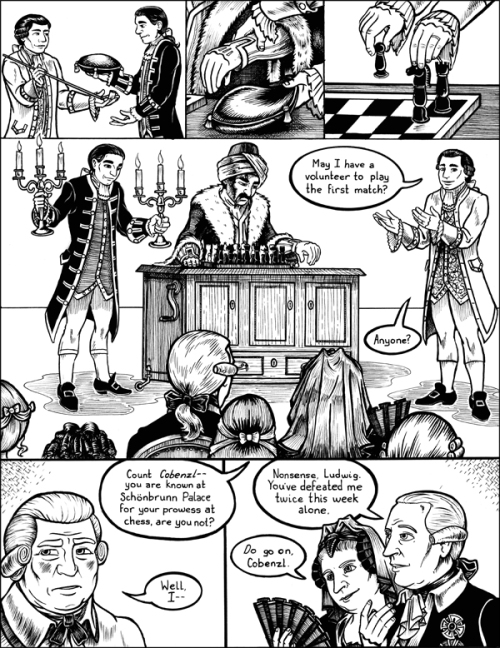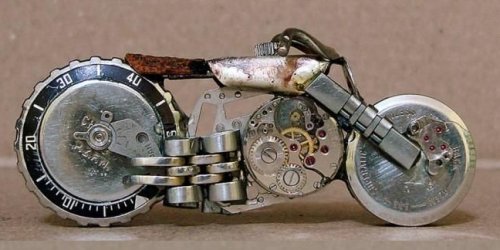If you ever thought what a Clockpunk plane would look like but could never quite figure it out, Kenneth Rougeau answers this question for you in Flights of Fancy.

A Blog on the Clockpunk genre of Science Fiction
If you ever thought what a Clockpunk plane would look like but could never quite figure it out, Kenneth Rougeau answers this question for you in Flights of Fancy.


Apparently this was a couple of years ago but I recently found out that the town of Vinci where Leonardo Da Vinci was born has put the contents of the Madrid Codices and the Codex Atlanticus online. They are also planning to put online digital copies of the Windsor folios and 12 notebooks from the Institut de France for a total of 12,000 pages. Here is a relevant excerpt from Wired.
While the digital notebooks offer advantages to make academics sob with joy — semantic search functions, clustered results — most of them vanish without a working knowledge of 15th-century Italian. (Forms in English are expected in about two months; an index of drawings in English is expected by year’s end.)
To index Leonardo’s designs and irregular vocabulary, text-mining company Synthema teamed up with engineers from the University of Florence and the Accademia della Crusca, Italy’s national language institute founded in 1582.
“Leonardo had a very modern way of jumbling things together, a true multitasker,” says Federico Neri, head of R&D at Synthema. “There are technical specifications next to shopping lists. Finding anything used to be mining in a literal sense.” Neri hopes to eventually develop a multilanguage version to help readers explore the notebooks.
Nonetheless, there are plenty of curiosities for the lay reader.
Even a quick spin may turn up, as it did on a recent once-over of the Codex Atlanticus, the spring-propelled vehicle thought to be a precursor to Mars rovers. And the high-resolution images are arguably as close as one will get to the real thing unless you’re Bill Gates.
There are references to a sketch in the Codex Atlanticus showing the backside of Leonardo’s comely assistant, Salaino, with penises speeding at him. When an e-Leo user’s attempts to find it fail, Taddei recites a folio number from memory with the cool aplomb of a professional used to stewarding odd requests.
The URL for the e-Leo project is as follows: http://www.leonardodigitale.com/ Registration is required but its free.

The Clockwork Game is a novelization of the story of the Turk in the form of a webcomic/graphic novel by the artist Jane Irwin. The Turk was a automation “invented” in the 18th century by a Hungarian Wolfgang von Kempelen which could play chess with people. People all across Europe flocked to see the automaton. Of course such technology did not exist back. The Turk was actually a hoax and there was a hidden contraption where a human would play chess but it would appear as if the automaton is playing chess. The automaton was named the Turk because its appearance was like that of the Turk. Most themes in Clockpunk deal with what might have been but as the Turk demonstrates there is plenty of room for exploring the hoaxes, the half-truths and perhaps even Clockpunk conspiracy theories! Anyway here is Jane’s description of the webcomic/ graphic novel.
Clockwork Game is a mostly-true story, a dramtization of actual historical events, retold with as little conjecture as possible. Some characters, whose names and histories were lost to the predations of time, had to be created almost entirely from whole cloth. Strong—but not ironclad—proof exists for the actions depicted in certain scenes. And, of course, dialogue and personalities had to be invented, based on whatever writings were available.
I was drawn to the incredible story of The Turk because it seems far too fantastic to actually be true, and yet with each new book and article, the facts became much more captivating than any fiction I could have created.
Here is an excerpt from the wbecomic. The comic is updated every Thursday.

The reader should also check out Jane Irwin’s official website at this URL.
For people who are interested in the pre-history of automata here is a link to a fascinating article by Elly Truitt whose dissertation I have previously mentioned on this blog. Given below is an excerpt from the article.
What is more remarkable than the presence of these metal people in this romance is the fact that automata in human form were found frequently in the pages of twelfth-century French romances—copper knights and damsels, golden archers, children, and guardians of tombs. The early twelfth-century chanson de geste Le voyage de Charlemagne contains a description of the emperor of Constantinople’s palace, upon which two golden children blow ivory horns and laugh in a lifelike manner when the wind blows. In Le roman d’Eneas, written around 1160, a metal archer ensures that the sanctity of Camille’s mausoleum remains inviolate. Another midtwelfth-century romance, Le conte de Floire et Blancheflor, mentions the speaking, moving statues of the eponymous lovers erected on Blancheflor’s mock tomb. The Roman d’Alexandre, completed around 1180, features two golden youths, made by augury (par augure) and enchantment (enchantement), armed with maces, guarding a drawbridge. In addition, two copper boys, armed with shields and pikes and made by enchantment (enchant) guard the tomb of the emir of Babylon. The First Continuation of Chrétien’s Perceval, completed in the first decade of the thirteenth century, has two figures guarding the tent of Alardin, an “Eastern” potentate, who can discern knight from churl and maiden from nonvirgin, and then bar the entrances of the latter to the tent.
Here is a Clockpunk novel, Alchemy of Stone, that I came to know of recently. The novelist, Ekaterina Sedia is a US novelist of Russian origin. I loved the tagline “A novel of automated anarchy and clockwork lust.” Clockwork lust? Where was I when they invented that? Here is the product description from Amazon.
Mattie, an intelligent automaton skilled in the use of alchemy, finds herself caught in the middle of a conflict between gargoyles, the Mechanics, and the Alchemists. With the old order quickly giving way to the new, Mattie discovers powerful and dangerous secrets – secrets that can completely alter the balance of power in the city of Ayona. However, this doesn’t sit well with Loharri, the Mechanic who created Mattie and still has the key to her heart – literally!
Killbox has a Flickr Set on Clockpunk related images. Aesthetically pleasing and would definitely put a smile on any Clockpunker’s face.
The New York Times has a nice article about mechanics in the pre-renaissance era and how the ancients thought about Mechanics. Its worth a read. It is definitely relevant to anyone interested in writing Clockpunk. Its a window for us into the minds of the ancient equivalent of mechanical engineers i.e., people like Archimedes. Thanks to Meika for pointing this out. Here is an excerpt.
Dr. Schiefsky teaches Greek and Latin as his day job and reads Thucydides and Sophocles in ancient Greek for fun. He also majored in astronomy as an undergraduate, and about nine years ago, feeling science-deprived, he joined a multinational research endeavor called the Archimedes Project, based at the Max Planck Institute for the History of Science in Berlin.
The Archimedes team studies the history of mechanics, how people thought about simple machines like the lever, the wheel and axle, the balance, the pulley, the wedge and the screw and how they turned their thoughts into theories and principles.
The textual record begins with “Mechanical Problems,” moves to Rome and then through the medieval Islamic world to the Renaissance. It ends, finally, with Newton, who described many of the basic laws of mechanics in the 18th century.
There are a surprising number of old, and extremely old, scientific texts that have survived the ravages of time in one form or another. The Archimedes Web site lists far more than 100, including Euclid’s geometry, Hero of Alexandria’s Roman-era technical manual on crossbows and catapults, medieval treatises on algebra and mechanics by Jordanus de Nemore and Galileo’s 17th-century defense of a heliocentric solar system.
The nice thing for Dr. Schiefsky is that hardly anyone reads the stuff. Scientists generally are not into ancient Greek or Latin, let alone Arabic, and most of Dr. Schiefsky’s colleagues work on literature, philosophy, philology or archaeology. In fact, Dr. Schiefsky suggests “about 100 people” worldwide work on both science and the classics.
By following the historical record, the Archimedes researchers have discovered that the evolution of physics — or, at least, mechanics — is based on an interplay between practice and theory. The practical use comes first, theory second. Artisans build machines and use them but do not think about why they work. Theorists explain the machines and then derive principles that can be used to construct more complex machines.
The Archimedes researchers say that by studying this dialectic they can better understand what people knew about the natural world at a given time and how that knowledge may have affected their lives.
“What do you do when you want to weigh a 100-pound piece of meat and you don’t have a 100-pound counterweight?” Dr. Schiefsky asked. “You use an unequal-armed balance, with a small weight on the long arm and the meat on the short arm.”
The uneven balance, known as a steelyard, is a kind of lever, and Dr. Schiefsky notes that it has a cameo in Aristophanes’ “Peace,” a comic fantasy about ending the Peloponnesian War. When a furious arms dealer cannot figure out what to do with a surplus war trumpet, Trygaeus, the central character, suggests pouring lead in the bell to make a steelyard.

Link via BoingBoing, Worth1000 is having a phtoshopping context for Clockwork Art. The basic idea is to infuse Clockwork in everyday and non so every day situations. Here is the link.

I spotted this on BoingBoing some time ago but did not get a chance to post it until now. This is a motorcycle sculpture made from watces made by the Brazilian artist Jose Geraldo Pfau Kings. Here is a whole selection of his works at this site. Speaking of Clockpunk Motorcycles, bicycles were within the realm of possibility many hundreds of years before they were invented in the real world. I wonder what can one say about the motorcycle?

[Image: Steampunk Deathstar]
I mentioned the Jacobean Space program some time back. Jake Lake also pointed out that he has a short story on an early 19th century story about the space program evolving out of steam powered technology. I was recently revisiting the story which got me thinking that indeed what would a space program look like if steam powered technology as well as steel and related alloys were missing. Would even be possible to talk about such a thing? Gun powdered had been around for a long time. Thus the question is, how far could such a project have gone if technology had advanced but without advancing into the Steampunk era?
Recent Comments